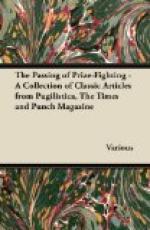IMPRESSIONS OF “IL TROVATORE.”
(BY A MATTER-OF-FACT PHILISTINE AT COVENT GARDEN.)
Act I. Scene 2.—Leonora’s confidant evidently alive to the responsibilities of her position. Watch her, for example, when her Mistress is about to confide to her ear the dawn of her passion for Manrico. She walks Leonora gently down to the footlights, launches her into her solo, like a boat, and stands aside on the left, a little behind, with an air of apprehension, lest she should come to grief over the next high note, and a hand in readiness to support her elbow in case she should suddenly collapse. Then, feeling partially reassured, she goes round to inspect her from the right, where she remains until her superior has completed her confidences, and it is time to lead her away. Operatic confidant sympathetic—but a more modern heroine might find one “get on her nerves,” perhaps. Manrico a very robust type of Troubadour—but oughtn’t a Troubadour to carry about a guitar, or a lute, or something? If Manrico has one, he invariably leaves it outside. Probably doesn’t see why, with so many competent musicians in the orchestra, he should take the trouble of playing his own accompaniments. And why does the Curtain invariably come down as soon as swords are drawn? Tantalising to have all the duels and fighting done during the entr’actes.
[Illustration: Manrico, a rather full-blown “Ghost in Hamlet.”]
Act II. Scene 1.—Azucena insists on telling Manrico a long and rather improbable story of how, in a fit of absorption, she once burnt her own son in mistake for the Conte di Luna’s, Manrico listens, as a matter of filial duty—because, after all, she is his mother—but he is clearly of opinion that these painful family reminiscences are far better forgotten. Perhaps he suspects that her anguish may be due to a severe fit of indigestion—the symptoms of which are almost indistinguishable from those of operatic remorse. At all events, he does not find his parent a cheerful companion, and, as soon as he finds a decent excuse for escape, takes it.
Scene 2.—The Cloisters of a Convent. Enter the Conte di Luna, with followers, to abduct Leonora. The followers range themselves against a wall in the background, until the Count has finished “Il Balen.” If their opinion was asked, they would probably be in favour of his making rather less noise about it, if he really means business—but of course it is not their place to interfere. Leonora enters to take the veil, with procession of nuns, preceded by four female acolytes—or are they pages?—in white tights, carrying tapers. The Count and his followers are evidently a little taken aback—an abduction not quite so simple an affair as they expected. While they are working themselves up to it, Manrico




